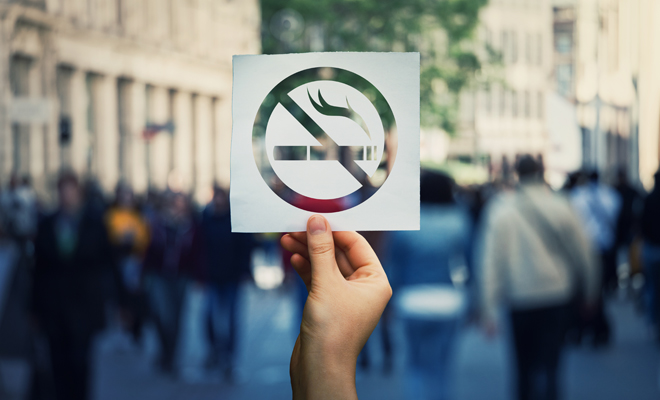Tobacco is an agricultural product, which is processed from the leaves of Nicotine abacus. According to the World Health Organization (WHO), tobacco products are those that are made totally or partially with tobacco, whether they are smoked, sucked, chewed or snorted. The main form of tobacco consumption, yes, is the inhaled form. All these products contain nicotine, a very addictive psychoactive ingredient (which is what generates, therefore, the addiction to tobacco).

When a person who is addicted to tobacco decides to, and begins the process, it is highly likely that they will develop the so-called nicotine withdrawal syndrome (already cataloged as such in manuals such as the DSM [Diagnostic and Statistical Manual of mental disorders] and ICD-10 (International Classification of Diseases).
Among the most frequent symptoms within this withdrawal syndrome we find anxiety when quitting smoking. What exactly is it and how to manage it? We give you some effective tips to manage withdrawal.
What are the first hours after quitting smoking like?
What are the first hours after quitting like? Are they the “peak” moment of anxiety? Within 24 hours of quitting, you are likely to feel tense and agitated. Tension can appear in the muscles, especially in the area.
According to studies, anxiety is one of the most frequent negative states associated with quitting smoking. This anxiety increases especially in the first three days after quitting tobacco, and, according to by Hughes (2007), published in the journal Nicotine and Tobacco Research, it can last up to two weeks or more.
Withdrawal symptoms associated with quitting smoking
Anxiety when quitting smoking is one of the main symptoms that appear after, but there is more. Some of the most common are:
-Depressive symptoms
-Nicotine cravings (or so-called “mono”; nicotine is the substance in tobacco that causes addiction)
-Anger, frustration and irritability
-Weight gain
According to the aforementioned study, close to half of smokers have reported feeling at least four of these withdrawal symptoms when quitting tobacco. On the other hand, according to another study, also by Hughes (2007), there are people who report other types of symptoms, such as dizziness, dreaming more or headaches.
Anxiety when quitting
When we quit smoking, we can experience this anxiety that we mentioned (especially the first few days after quitting the habit). Anxiety is a state of hyper activation of the organism that is accompanied by symptoms such as: sweating, nausea and vomiting, dizziness, tachycardia, increased blood pressure, irritability, negative thoughts, etc.
This anxiety will be more or less intense depending on the addiction we had to tobacco, and also depending on the number of cigarettes we smoked per day. In people who suffer from this, normally, the greater the addiction, the greater the anxiety.
This anxiety can be addressed at a pharmacological level (there are specific drugs for this), or also at a psychological level (with techniques such as relaxation). If you want to manage this anxiety, the first thing we recommend is that you ask for professional help. However, if you want to start approaching the suggestions that could help you calm this anxiety, we propose some.
How to manage anxiety when quitting smoking?
How to manage anxiety? Here are some suggestions that can help you:
- Keep in mind that anxiety is a transitory state, which will undermine over time until it disappears.
- Reserve moments of tranquility during the morning and at night, where you can be in a calm and relaxed environment.
- Do sports or walk a little every day; Sport It is a very effective tool to combat anxiety.
- Cut down on caffeine during the day (limit coffee, tea, or drinks like soda).
- Practice progressive relaxation (Jacobson’s progressive muscle relaxation may be a good option).
- Practice meditation or mindfulness for a few minutes a day.
- Practice other, such as deep or diaphragmatic breathing.
- Consult your doctor about nicotine replacement products and other medications.
We are now going to talk in a little more depth about some of these strategies to manage anxiety when quitting smoking:
The importance of sports
Among one of the suggestions that we offered you when it comes to managing anxiety when quitting smoking, we found the practice of sport. Most of the studies that address the relationship between physical exercise and anxiety conclude that regular exercise can reduces the level of anxiety, specifically state anxiety (anxiety reaction experienced in a specific and limited situation).
SW, if and feel anxious, propose to do some sport: if you haven’t practiced it for a long time, you can start with short routines or by going for a walk for half an hour a day. They say that practice makes a habit, so, you’ll see how over time you end up including sports in your routine. Sport not only fights anxiety while you practice it, but also after it. When we finish playing sports, we feel relaxed since; in addition, we have released a large amount of endorphins.
Caffeine as a stimulant
Caffeine is a stimulant substance; that is why people who are already nervous or anxious and who also consume caffeine can be even more so. If you’re going through a tobacco detox phase and feel that initial cravings, limit your caffeine intake. This will help you reduce the levels of hyper activation in your body. You can do it gradually or abruptly, depending on how dependent you are on coffee.
But not only coffee contains caffeine, but also other drinks such as tea or some soft drinks, as well as energy drinks. Cocoa also contains caffeine, as well as in weight loss and sports performance supplements, ice cream, cakes and a wide variety of sweets. There are even medicines and certain cosmetics that also contain caffeine.
As a fact to take into account, the European Food Safety Authority (EFSA), which is the body of the European Union that offers guidelines regarding food consumption, recently published a study to determine what is healthy when it comes to daily caffeine intake.
According to the EFS, the total amount that a person’s body can process without posing any risk to the body is 400 mg per day; to get an idea of this amount, a 200 ml cup of brewed coffee is equivalent to 90 mg of caffeine.
The benefits of deactivation techniques
Both relaxation and deep are effective techniques to manage anxiety, and may be useful to combat anxiety when quitting smoking. These are two techniques especially used in anxiety disorders, very effective for them, which imply a deactivation of the organism.
Within them we find a great variety of these: mindfulness, yoga, Jacobson’s progressive muscle relaxation. To start putting them into practice, you can turn to a professional who is dedicated to it, or try video on the Internet as a first approach to them. There are also many books and resources related to these techniques.
Managing withdrawal and anxiety when quitting smoking is possible
Quitting smoking is not easy, either because of the first symptoms after giving up this habit, or because of the dependence our body (and our mind) feels on said substance. It is difficult to make the decision, but, above all, to keep it. But it is possible to achieve it! And leaving behind this toxic habit will allow you to invest in your health and your quality of life.
If you’re experiencing anxiety about quitting, the good news is that it can be combated. We’ve offered some ideas for tackling it, though you’ll all need to find the strategies that work best for you. Beyond all this, remember that maintaining healthy lifestyle habits (eating in a balanced way, resting…) can help you feel better, as well as stronger to face this personal challenge.






